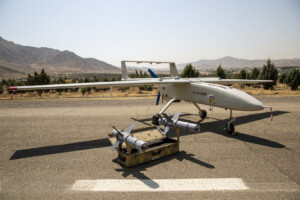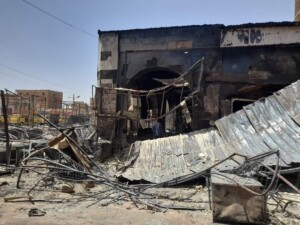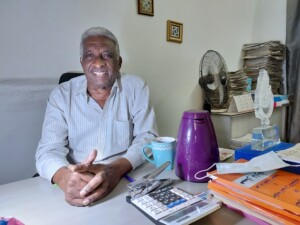Surviving the Antonovs in Darfur
Many people in Darfur recognise the sound of Sudan’s Antonov aircraft that indiscriminately bomb villages. Villagers, however, manage to flee and outwit the terrifying Antonovs.
By Kamal El Sadig
Many people in Darfur recognise the sound of the Antonov aircraft of the Sudanese Air Force. The converted Russian-made cargo aircraft are infamous in the western region of Sudan because their arrival means the indiscriminate bombing of villages. Civilians living in these danger zones in Darfur, however, manage to flee and outwit the terrifying Antonovs.
Men in a village in East Jebel Marra, in the part of South Darfur, have gathered under a tree to read the Koran and chat about the terror from the sky. “When people hear the sound of the Antonov, they flee in all directions as you never know where it is going to fall,” one of the men says.
The sound of the cargo aircraft’s engine is unlike that of a helicopter or a jet fighter and sets in motion a desperate attempt by villagers to find a shelter with their family and animals as quickly as possible. Unfortunately the attempts are often not successful for all people.

The area of Leeba, East Jebel Marra (RD)
“Since the war erupted in Darfur in 2003, we have never had a rest from the Antonovs. It always circles around this area, bombing everything,” a man complains. He thinks that because of the geological structure of the Jebel Marra Massif, the pilots have no idea where their bombs will fall.
The Antonovs are only capable of rolling barrel bombs out of their cargo hatch. The barrels, filled with shrapnel and high explosives, are thus far from accurate. As the weapon is deemed indiscriminate it is illegal under international law.
Luckily, one of the men says, people can avoid the explosions because the bombs are dropped from a high altitude. “By the time it is comes near the ground you can see it, run to the opposite direction, and hide.”
The large tree where the men have gathered stands near the village of Leiba. They come together every day to pray and read in the afternoon. One by one the Darfuris share their stories and make fun about how they have dealt with the threat of the Antonovs in their lives.

The men from Leeba gathered under the tree to read the Koran, pray to God to avoid any Antonovs bombing the area, and chat (RD)
“Do you know the son of Adam Abaker?,” a man asks the group. “He is large and quick-tempered as a child. The children gave him the nickname ‘El Antonov’ and now everybody in the village calls him that.” The men laugh.
“We lay-down shimmering metal at a distance from the village, so the pilot may bomb this fake target.”
Not all of the crude barrel bombs explode. The children are taught not to approach the unexploded bombs: the adults carefully gather the explosives, circle them with thorns, and post a red cloth on top of it as a warning.
Leiba is a crossing point for people who have been displaced by fighting in western El Malam, and those who have fled from Deribat, Jawa, Suni and Berta in Jebel Marra. Enriched with deep caves, high mountains, and wide valleys the area provides some protection from both air raids as military ground operations that are aimed against the armed rebels.
 Outwitting the Antonovs
Outwitting the Antonovs
The villagers have learned to draw the attention of the Air Force pilots by laying-down shimmering metal about half a kilometre away from their farms or villages. From the air, the metal looks like the rooves of houses. “A bright metal pot will often distract the pilot because he assumes it is the target, and drops his bombs there,” a farmer says. “Then everybody is relieved that no harm has been done.”
The aircraft can also be heard circling above the area in the daytime to establish its target, and then returns at night to bomb the area from a lower height, the men explained. Such exploratory flights often are a prelude to an intensive bombardment.
“We then build a fire about half a kilometre from the village and extinguish all the fires around our homes, and the Antonov will bomb the fake target.” Again laughter resounds from under the tree.
Radio interception
One of the men interrupts: “Do not forget the FM.” He points to a small radio on which he listens to Radio Dabanga. His radio’s bandwidth can pick-up the FM frequency of an Antonov flying in the area.
“We always make sure that the FM is on when we hear an Antonov, so you can hear what pilots say and where they plan to drop the bombs. It helps us to run into the opposite direction. When they are distracted you can hear them shout and curse.”
He remembers that the pilots spoke in English on their radio at first, until they realised that young men in Darfur can often understand English. They have now turned back to Arabic – one of the jokes that people in the village share about the Antonovs.

The tree where the Koran readers from Leiba gather every day keeps them out of sight from attackers, too (RD)
The men notice that the constant threat of being struck by an explosion has changed their behaviour too. Amid the group sits a villager who went to stay with a relative in El Fasher, the capital of North Darfur. There, the sound of a simple aircraft scared his children into hiding under the beds.
“His house was nearby the airport. I had to explain to the people there that this is what people do back here when we hear the scary Antonov: we run to a cave or valley to protect ourselves.”
Protecting property
From a distance, it is hard to recognise Leiba if you are not from the area. Most houses in East Jebel Marra have a roof of zinc, making it a prominent target for the Air Force as it shines in the sun. Villagers started to cover the rooves with grass and straw. Others have built their houses on mountain tops, as a lookout for danger and to watch over the people living down in the valley.

A man and woman in Leeba cover a roof with hay and rocks to make it a less easy target for pilots (RD
“You may find thousands of holes, storing valuable properties, dug and sealed in this mountain.”
Almost no one in East Jebel Marra keeps their precious property in their house, where it is at risk of being stolen by militiamen that frequently raid the villages. People have figured out a way to keep their possessions safe: buried in to'arra bewot, or storage rooms dug deep in the ground.

The hole, usually about four metres deep, is dug at night so that only trusted family members know its location. It is sealed with big stones and they “are absolutely safe”, one of the Koran readers says. “You may find thousands of to'arra bewot in the mountain.”
“We have learned through painful experiences how to deal with the Antonovs,” he adds. “This is our land, we are not going anywhere, and we therefore have to create new ways to encounter this situation. We have no place else to go.”

Leiba (RD)
The conflict in Darfur
Darfur is largely disrupted by armed conflicts. In April 2003, rebels took up arms and rose up against the government, accusing it of neglecting the Darfur region. The government responded with a counter-insurgency campaign, that spilled over to the rest of Darfur and Chad in 2004 and 2005. Civilians have come under attack from government troops, the Air Force, pro-government militia and rebel groups since then.
In 2009, the outgoing military commander of UN peacekeepers said the conflict was effectively over. But fighting escalated in 2010, forcing tens of thousands more to flee their homes. This year, over 2.6 million people have remained displaced from their homes in Darfur, according to international organisations. As of 13 March, more than 110,273 people were reportedly displaced from the military offensive and attacks in Jebel Marra to various locations in North, Central and South Darfur.
Russian Mi-17 and Mi-32 helicopter gunships, Sukhoi and MiG-29 fighter jets, and Chinese-made A-5 ‘Fantan’ jets have all been sighted in Darfur according to the Small Arms Survey, as well as white Antonov 26 transport aircraft used as crude bombers.
Also in Features:
Darfur's East Jebel Marra: Surviving under siege












 and then
and then